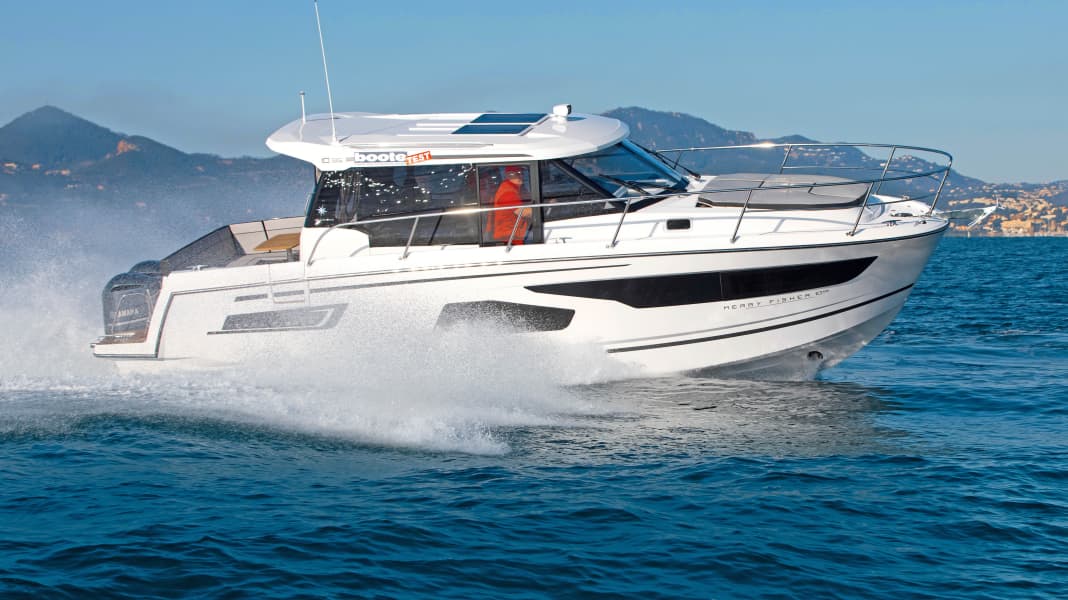
The development continues: While the Merry Fisher model range from Jeanneau has beenprimarily for sport anglers the focus of the new flagship in the series is on family-friendliness. Of course, you can still catch fish out of the water with the almost eleven metre-long 1095 - but it's not the only boat in the series.but with significantly more space and comfort on and below deck. If pure functionality is more important to you, the French shipyard also offers the Marlin in three different sizes.
The most important difference between the two series lies in the deck layout: the Marlins are designed as a walkaround, where you can walk around the entire boat with a fishing rod in your hand and don't even have to watch out for steps.
The Merry Fisher concept, on the other hand, focuses onAsymmetry. The design is limited to a sufficiently large (and raised) side deck to starboard, which makes the saloon wider and more spacious. There is only an "emergency deck" on the port side.
Our test boat iswith two 300 hp Yamaha engines equipped. Outboards have one advantage: there is significantly more space for guests on board. The shipyard has also accommodated three separate cabins and a separate bathroom with shower and toilet. In terms of overall workmanship, there is little to criticise about the first boat to be presented to the public.Not everything is perfect yetbut this is due to the construction number and the wealth of ideas that have been realised.





Driving and manoeuvring
Two motors with counter-rotating gearboxes and the bow thruster (as an extra) guarantee easy manoeuvring in confined spaces. With both gearboxes on forward or reverse, full circles of up to three boat lengths are possible. From a speed of around 6 knots upwards, the waves are disruptive to the surroundings.
We measured the slowest planing speed at 13 kn at 3000 rpm. The reason why our test boat starts planing early and maintains visibility during the transition to planing is the hull construction. Jeanneau has fitted the 1095 with what are known as stowage wedges. They act like permanently installed trim tabs that lift the stern early as the speed increases.
However, in order to be economical when travelling at high speeds, the engine speed must be increased to 4000 rpm and the speed to 25 knots. With one tank of fuel, you then have a range of 205 nm plus 15 % reserve - we rate this as"Good".
At full throttle, the range shrinks to around 131 nm; at slow canal cruising at 6 knots, it increases again to 308 nm, plus reserves in both cases. The extreme manoeuvres are moderate, as you need eight (somewhat stiff) turns from one full turn to the next.
So not much happens when the steering is jerked. What's more, the propellers will also reach into the void in tight bends at full speed, while the stern of the boat swerves slightly to the side. Safety plus: If one of the two motors should fail, it is possible to get the boat planing with just one.
In the cockpit, the sound pressure meter exceeds the 85 dB/A limit from 25 kn (3500 rpm), in the closed saloon we measured 75 dB/A at cruising speed and no more than 83 dB/A at full throttle. The driver sits in a longitudinally adjustable bucket seat and has everything in view - and under control.
With the exception of port curves, visibility from the driving position is maintained in all directions even when gliding. The dinette seat can be converted into a passenger seat in no time at all. A grab handle is provided.
A large sliding door provides access from the driving position to the starboard side deck. On the opposite side, the window at dinette level can be opened. This also provides access to the port centre cleat from the inside to attach a line.
Technology, safety and cockpit
The fact that the two fuel tanks are located on the outside has the advantage that there is still storage space amidships next to the batteries, which can also be used for a generator. The battery circuit is located in the galley.
While the fuses under the driving position are easily accessible from the starboard cabin, we rate the installation location of the fuel pre-filters without water alarm sensors as rather service-unfriendly.
Electric bilge pumps are available. If necessary, the pumps can also be operated manually. The fuel valves can also be closed manually. The handrails on the cabin roof could be longer. However, access through a bulwark door or aft via the bathing platform is convenient. Another detail: thick fenders are a must, as the railing protrudes over the side of the boat.
Living and equipment
Three cabins in this boat class are a rarity. In terms of space, you have to cut back a little, but you don't feel cramped either. There are fixed berths for six people and two more in the converted dinette.
There is no shortage of storage space on the aft deck and, with the table lowered, the seating area can be transformed into a sun lounger. If you order a canopy, you are protected from all weathers. In the almost completely glazed saloon, the dinette on the port side offers space for four people. The galley is located opposite - so you can prepare fresh catches for the family right away.
CONCLUSION
The fishing boat has been transformed into a cosy family cruiser with plenty of space. Even longer trips are possible with the Merry Fisher 1095, yet it remains a popular boat for hobby anglers. The workmanship is right, the layout is well thought out and the sailing characteristics are safe.

